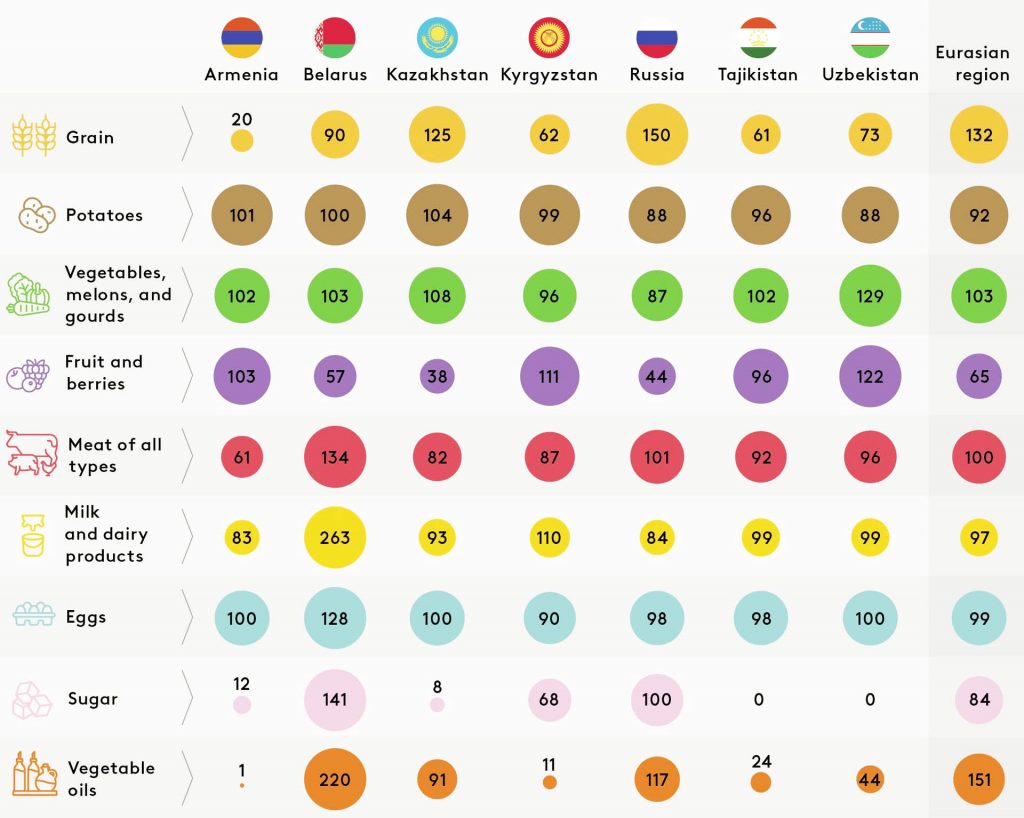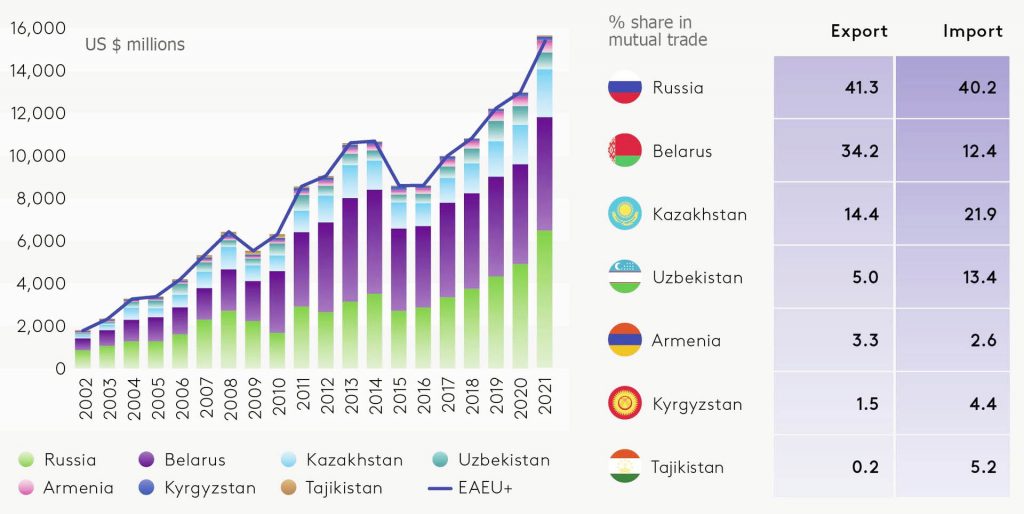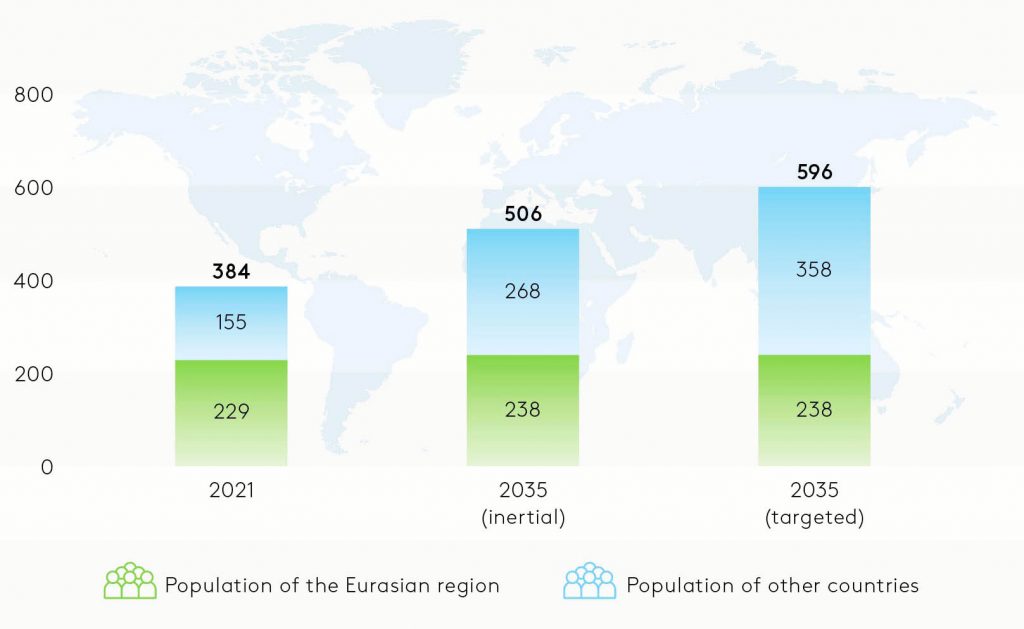_ Dr. Evgeny Vinokurov, chief economist, Eurasian Development Bank and Eurasian Fund for Stabilization and Development. Moscow, 21 April 2023.
The EDB’s new analytical report, “Food Security and Agro-Industrial Potential of the Eurasian Region”, proves that agriculture is a key element of the long-term economic specialization of the Eurasian region. Calculations demonstrate that the region not only guarantees its own food security, but by 2035, it will also be able to fully provide food for 600 million people. To realize the region’s globally unique potential it is necessary to accelerate the development of the technological base of the agro-industrial complex, improve agro-logistics and storage systems, support major producers, stimulate cooperation among small farms, and eliminate barriers and restrictions on mutual trade within the EAEU.
Global food security is worsening. Humanity is failing to meet UN goals for ending hunger – in 2022, the world had 828 million hungry or malnourished people. EDB analysts project that high food prices will persist for an extended period because of population increases and growing consumption in rapidly developing countries, as well as under pressures associated with the negative effects of global warming, high prices for energy and energy derivatives (including fertilizers) and shortages of skilled labour and new agricultural land. In this context, lower food availability will increase the value of food resources.
The Eurasian region (the study covers five EAEU countries, Tajikistan and Uzbekistan) is in a unique position to boost food production and exports both extensively (by expanding farmland) and intensively (by increasing yields). In addition, the region has already formed an ecosystem of production factors and linkages. It is also very close to the world’s largest prospective food markets, with a total population of more than 3 billion.
In its new study, the analytical team of the EDB concluded that the level of self-sufficiency in the Eurasian region for most food products already exceeds 80-95%. The region as a whole ensures its food security. The self-sufficiency rates are the highest for grains (132 percent) and oilseeds (151 percent) and the lowest for fruit (65 percent). However, the region’s countries maintain significant differences in their food production and consumption patterns.
Figure 1. Eurasian countries’ food self-sufficiency rates

Source: EDB calculations.
The development of mutual food trade provides significant support to the countries in the region. Over the past twenty years, their mutual agricultural exports have grown by a factor of 8.5, to 15.4 billion USD in 2021, accounting for 33.6 percent of the region’s agricultural exports. Expanding mutual trade and cooperation between Eurasian countries and preserving well-functioning international trade mechanisms are important elements of the region’s food security.
Ensuring food security in all countries of the region requires an expanded understanding of it, based on the unhindered functioning of export and import channels. A country does not need to produce all types of food to achieve food security. Depending on climatic and other conditions, it may be unfeasible or impossible to produce certain types of food in the necessary amounts. Effective foreign trade mechanisms make it possible to generate revenue by exporting the most profitable food surpluses and import the items the country lacks, which may be more cost-effective than setting up domestic production.
Figure 2. Mutual trade in food between Eurasian countries

Source: EDB calculations using Trademap data.
Scenario calculations made in the report indicate that unleashing the Eurasian region’s agricultural potential will help to fully meet the food needs of 600 million people by 2035, including 240 million people within the region and an additional 360 million beyond. Given the growing global importance of food and provided that Eurasian countries maintain a sufficient level of food security, the region could almost double its food exports – from 40 billion USD in 2021 to US 74 billion USD. China, the Middle East and North Africa and India are the most promising export destinations.
Figure 3. Quantity of population provided with food from the Eurasian region (million people)*

Source: EDB calculations. * Calculated as of 31 August 2022.
The report emphasizes that the countries need to nurture major national and regional producers. This is expected to facilitate the construction of logistics centres, the purchase of modern vehicles and equipment and the use of more effective financing instruments, including with the involvement of international development institutions such as the EDB. However, nurturing major and effective market players is challenging, especially in Central Asia and the Caucasus. For this reason, it is recommended to incentivize cooperation between small farms (by establishing an agricultural marketing system, a network of machinery and tractor stations, maintenance and procurement centres, etc.).
The advancement of agricultural logistics and storage will help to realize the region’s potential. The Eurasian Commodity Distribution Network (ECDN) will eliminate transport and logistics constraints in Eurasia that account for 40 percent of the countries’ agricultural losses, while about 70% of food that could be produced within the region is imported from third countries. The newly built logistics systems should be based on modern digital technology. The ECDN will help to make planning more accurate, shorten delivery times, make sure that products are delivered safely and improve the efficiency of payment services and the speed of ordering and returns.
Getting access to promising markets would require significant improvements in logistics in southern and eastern destinations. This is another proof of the need for a single Eurasian Transport Framework, including motor and railroads, seaports, border crossings and other infrastructure. With the potential growth in food supplies to Asia, the Middle East and North Africa, the International North–South Transport Corridor will become increasingly important.
The following should also help to effectively realize the Eurasian region’s food potential:
- Reducing the dependence of the region’s agriculture on the imports of investment and intermediate goods by developing domestic production (certain types of agricultural machinery and components, sugar beet seeds, winter rape, potatoes, sunflowers, corn and peas, hatching eggs and chickens, as well as breeding stock, livestock equipment, feed supplements and veterinary drugs);
- Fostering the development of the agricultural technology base with state support for seed supplies and pedigree cattle breeding. The focus should be on the restoration of the countries’ own breeding and genetics practices;
Import substitution in mechanical engineering, including high-tech segments focused on upgrading the road and rail fleets (refrigerated vehicles, railcars and containers, tanks for vegetable oils, etc.) as well as maritime transport; - Strengthening the financial infrastructure for the agricultural sector, including the development of regional commodity exchanges, mutual settlements in national currencies and a unified insurance and reinsurance infrastructure to support exports;
- Creating an enabling regulatory environment aimed at eliminating barriers and restrictions within the EAEU (in technical regulation, transport, government procurement and taxation policies); and
- Improving the efficiency of water and energy management in Central Asia and promoting the use of water-saving technologies as a component of food security.
The full version of the report “Food Security and Agro-Industrial Potential of the Eurasian Region” is available at the EDB website and Evgeny Vinokurov’s personal website.
